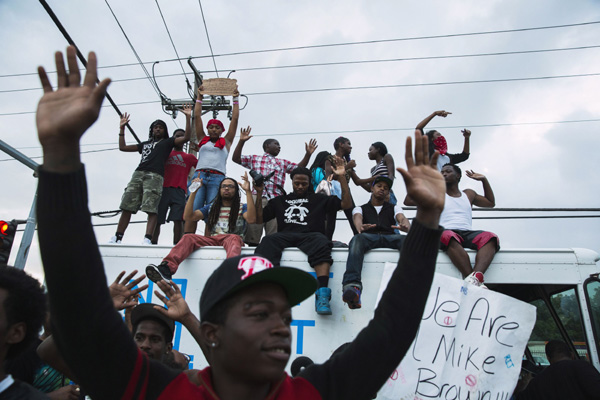 |
|
Demonstrators gesture and chant as they continue to react to the shooting of Michael Brown in Ferguson, Missouri, in this file photo taken August 17, 2014. [Photo/Agencies] |
As a young boy growing up in the city of Detroit, Michigan, in the 1950s, we were taught that police were our friends. Their shiny badges seemed to confirm this with the Latin motto Tuebor — I will defend.
Fast forward to today’s United States and it seems the police are not defending us, but rather defending themselves against members of the community killing more than 1,000 people last year. US police have killed people at a rate of more than two a day this year, The Washington Post reported on May 31.
Recent incidents such as in Baltimore, Maryland, are the tip of the iceberg. How did we reach this nadir, and what can be done?
Even though we have a black president in the White House, Dr Martin Luther King’s dream still eludes us. There is just too much racism in the US. This leads to an us-versus-them mentality.
Rather than being “a melting pot”, we are a stew of separate and often unequal groupings. This is reflected in how they view police.
While 83 percent of whites have confidence that police will do a good job of law enforcement, only 63 percent of Hispanics and 52 percent of blacks feel that way. And even more tellingly, 74 percent of whites have confidence in the police to not use excessive force on suspects, 45 percent of Hispanics and a mere 36 percent of blacks feel that way.
Just getting the various groups communicating will help open lines of communication and break the great divide. President Barack Obama’s Interim Task Force for 21st Century Policing report issued in March is replete with examples of community collaborations that work. Police athletic leagues and engagement with teens are time-tested winners. Everyone in China has a name card, right? The task force recommends that each cop have one too.
While I consider myself moderate-to-liberal, I am sympathetic to the police. The US is awash with guns, more than one for each man, woman and child. Indeed, 80 percent of the people shot by police had a weapon, usually a firearm, and nearly 25 percent were mentally challenged. But I believe that in this age of high technology, the use of primitive weaponry can often be replaced or augmented by newer less lethal weapons well beyond TASERS and stun-guns such as conductive energy devices (or CEDs) which have been shown both to decrease the number of fatal police interventions and reduce injuries.
Another simple new technology solution is the use of body worn cameras shown to drastically reduce the incidents of use of force, and significantly lower the number of citizen complaints.
Social media, too, can play their part. The police and communities they serve can be bridged by two-way interactive sites that both inform and create dialogue.
Among the biggest complaints of American citizens in predominantly black Ferguson with a predominantly white police force was aggressive traffic law enforcement and court fines to generate income. And people who don’t pay go to the slammer. In 2013, Ferguson had an astounding 33,000 outstanding arrest warrants, absurd given its population of only 21,000! This festering issue clearly needs to be addressed.
Interestingly, we don’t even officially know the number of police-related civilian deaths. In this Big Data era, we only know from Federal Bureau of Investigation statistics that there have been about 400 “justifiable police homicides” annually. Yet the website, killedbypolice.net, which tracks news reports lists 1,104 police-caused deaths for last year. Having good data to analyze, including public opinion data, can only make for better studies forming the basis for sound policy decisions.
Like China, the US is a great country always seeking to better itself. Justice, equality and fairness should be part of the American dream that will surely be realized.
The author is a senior adviser to Tsinghua University and former director and vice-director of ABC Television in New York.

I’ve lived in China for quite a considerable time including my graduate school years, travelled and worked in a few cities and still choose my destination taking into consideration the density of smog or PM2.5 particulate matter in the region.